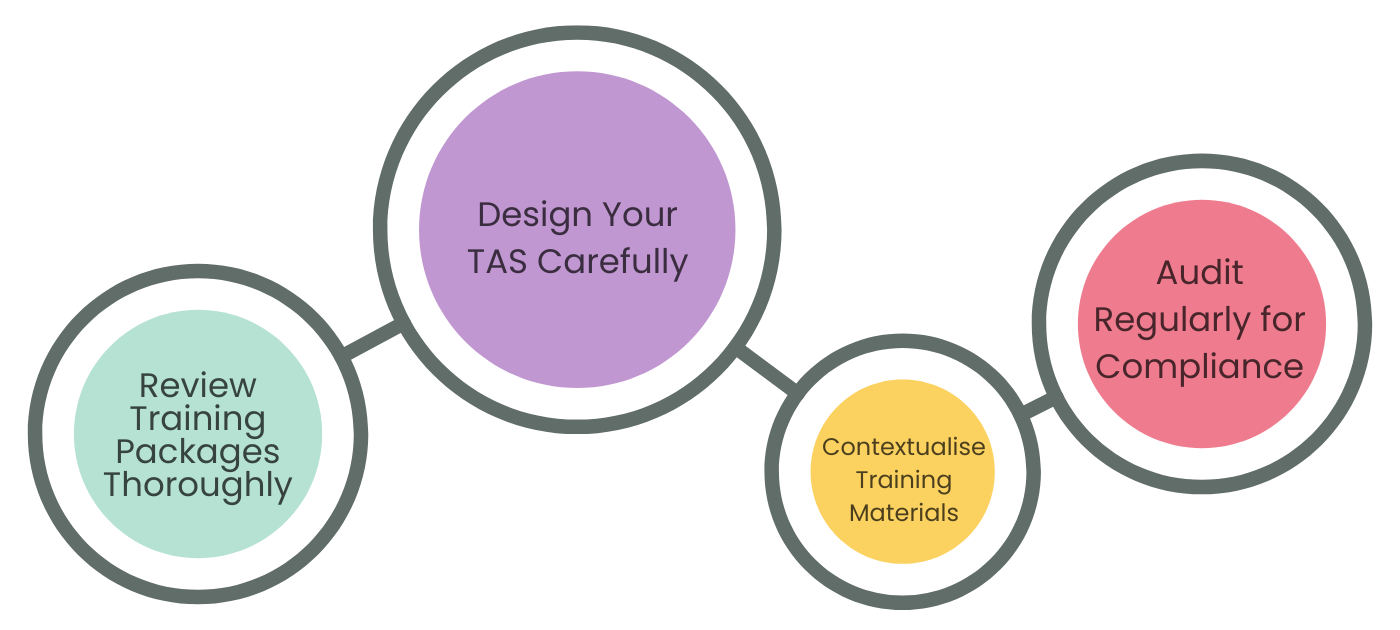In Australia’s Vocational Education and Training (VET) sector, understanding how qualifications are constructed is vital for maintaining compliance, delivering relevant training, and supporting learners in gaining real workforce outcomes. A key element in this framework is the qualification pack. This concept, along with packaging rules, plays a pivotal role in how Registered Training Organisations (RTOs) design and deliver courses.
Whether you are building a new training product, auditing your TAS, or contextualising content for specific learner groups, having a strong grasp of these structural components is essential for quality assurance and compliance.
Understanding and correctly implementing qualification packs is crucial for RTOs to maintain compliance and deliver effective training. For a deeper insight into the components of a unit of competency, refer to our guide on Understanding the Key Components of a Unit of Competency in RTOs.
What Is a Qualification Pack?
A qualification pack is a formalised grouping of units of competency that, when completed, lead to the award of a nationally recognised qualification. These packs are developed within training packages approved by the Australian Industry and Skills Committee and published on training.gov.au.
In simple terms, a qualification pack defines a particular job role or occupational outcome and ensures that the training offered supports the development of skills, knowledge, and performance standards required in the workforce.
Each qualification pack comprises two categories of units:
Core Units
These are mandatory units that every learner must complete. They cover the foundational knowledge and skills that apply universally to a particular qualification.
Elective Units
These are optional units that RTOs can select based on learner needs, industry requirements, and training contexts. Electives offer flexibility and allow RTOs to tailor training to meet emerging industry trends or regional demands. However, these electives must still comply with defined packaging rules, which regulate the type and number of electives that can be chosen.
Understanding Packaging Rules
Packaging rules are the structural guidelines that define how many and which types of units must be completed to achieve a specific qualification. These rules are published in the official qualification documentation available on training.gov.au and are essential to the compliant delivery of training products.
A typical packaging rule might require the completion of a total of 15 units, such as:
- 10 core units
- 5 elective units selected from a specified list or groupings
Some packaging rules also allow a limited number of electives to be imported from other training packages or accredited courses, which provides further flexibility. However, all choices must still maintain the integrity of the qualification and align with the intended vocational outcome.
RTOs must review packaging rules carefully when designing Training and Assessment Strategies (TAS) and when contextualising learning and assessment materials. Incorrect application of these rules can result in non-compliance during audits and negatively affect student outcomes.
Adhering to these rules is essential for RTOs to ensure that the qualifications they offer are recognized and meet the expectations of both learners and industry stakeholders. To avoid common pitfalls, consider reading our article on Avoid These 5 Common Training and Assessment Strategy Mistakes in Your RTO.
Importance of Qualification Packs and Packaging Rules
The proper implementation of qualification packs and adherence to packaging rules are essential for several reasons:
Compliance with ASQA Standards
RTOs are regulated by the Australian Skills Quality Authority (ASQA) and must align their course delivery with the Standards for RTOs 2015. Incorrect packaging can breach Clause 1.1 (Industry engagement), Clause 1.6 (Assessment system), and Clause 2.2 (Monitoring third parties).
Relevance to Industry
Qualifications structured using the correct combination of core and elective units ensure that learners are equipped with competencies that align with real job roles, workplace functions, and current industry expectations.
Flexibility for Learners and Employers
The ability to select electives allows RTOs to contextualise qualifications for different learner cohorts or sectors. For example, a Certificate III in Business could be adapted to suit customer service, administration, or medical reception roles based on the electives chosen.
Quality Assurance
Following packaging rules ensures that the qualification is delivered in a way that is recognised across Australia, supports articulation pathways, and maintains national standards for workforce capability.
To further explore these standards and how to avoid non-compliance, refer to our blog on Avoiding Common TAS Mistakes.
For a comprehensive understanding of contextualizing training packages to meet diverse learner needs, refer to our guide on The Ultimate Guidelines for Contextualisation of Training Packages for Diverse Learners.
Implementing Qualification Packs in Your RTO
To successfully implement qualification packs and maintain compliance:

- Review Training Packages Thoroughly
Always start by analysing the latest qualification documents on training.gov.au. Look for updates or amendments to packaging rules and ensure your trainers and course designers are aware of these details. - Design Your TAS Carefully
Use compliant TAS templates and map each unit selection back to the official packaging rules. Be sure to include rationale for elective selection and evidence of industry consultation. - Contextualise Training Materials
Tailor your learning and assessment resources to reflect your specific learner cohort, industry type, and delivery mode. Avoid using generic or misaligned materials that don’t reflect the chosen electives. - Audit Regularly for Compliance
Conduct internal validation of your training plans, resource mapping, and assessment tools to ensure alignment with packaging rules and ASQA expectations.
For practical guidance on contextualisation, read our Comprehensive Guide on How to Contextualise Units of Competency in RTOs.
Resources to Support Your RTO
VET Resources offers a range of materials to assist RTOs in implementing qualification packs effectively:
- Learning and Assessment Kits: Comprehensive resources for various qualifications. Explore our RTO Training Resources.
- Training and Assessment Strategies: Templates and guides to develop compliant strategies. Visit our Training and Assessment Strategy collection.
- Contextualisation Guides: Support for tailoring training to specific learner groups. Start with The Ultimate Guidelines for Contextualisation.
- Industry-Specific Resources: Whether you need materials for business, aged care, construction, or mining, explore our RII Resources Online for sector-specific qualifications.
Final Thoughts
Understanding and correctly applying qualification packs and packaging rules is essential for RTOs to deliver high-quality, compliant, and industry-relevant training. By leveraging the resources and guides provided by VET Resources, your RTO can ensure that it meets regulatory requirements and provides valuable outcomes for learners.
To access high-quality, compliant resources for your RTO, visit vetresources.com.au or contact our team for expert support.
Frequently Asked Questions (FAQs)
- What is a qualification pack in the VET sector?
A qualification pack in the VET sector refers to a structured collection of core and elective units of competency that, when completed, lead to a nationally recognised qualification. It defines the knowledge and skills required for a specific job role or function and is built according to packaging rules outlined in training packages on training.gov.au.
- How is a qualification pack different from a training package?
A training package is a broader framework that includes multiple qualifications, units of competency, and assessment guidelines across an industry sector. A qualification pack is a specific group of units within that training package that make up a single qualification.
- What are packaging rules?
Packaging rules are guidelines that specify how many core and elective units must be selected to form a complete qualification. These rules ensure that the qualification is valid, recognised, and reflects industry standards. Packaging rules are listed in the official qualification details on training.gov.au.
- Why are packaging rules important for RTOs?
Packaging rules help RTOs structure their qualifications properly, ensuring compliance with the Standards for RTOs 2015. They also support learner outcomes by maintaining the integrity and consistency of nationally recognised training.
- Can RTOs choose any elective units they want?
No. Elective units must be selected according to the packaging rules. Some packaging rules allow for limited electives from other training packages, but all selections must maintain the intent and job outcome of the qualification.
- How can I check the packaging rules for a qualification?
You can visit training.gov.au and search by the qualification code (e.g., CHC33021). The packaging rules are listed under the “Qualification details” section of each training package.
- What happens if an RTO doesn’t follow packaging rules correctly?
Non-compliance with packaging rules can lead to audit findings, qualification cancellations, or training not being recognised by employers or regulators. It’s important that every course delivered by an RTO adheres to the exact specifications of the qualification pack and packaging rules.
- Where can I get resources that are aligned with packaging rules?
VET Resources offers fully mapped and audit-ready training materials aligned with current packaging rules and unit requirements. Visit our shop for the latest compliant RTO training resources and Training and Assessment Strategy templates.
- Can qualification packs be contextualised for specific industries?
Yes. While core units remain fixed, elective units can be chosen to suit particular industry sectors, learner needs, or delivery modes. Contextualising content helps RTOs deliver more relevant training. Learn how in our blog: The Ultimate Guidelines for Contextualisation of Training Packages for Diverse Learners
- Who decides the structure of qualification packs?
Qualification packs are developed by Industry Reference Committees and Skills Service Organisations in consultation with industry stakeholders. They are endorsed by the Australian Industry and Skills Committee (AISC) and published by the Department of Employment and Workplace Relations on training.gov.au.
Disclaimer:
The information presented on the VET Resources blog is for general guidance only. While we strive for accuracy, we cannot guarantee the completeness or timeliness of the information. VET Resources is not responsible for any errors or omissions, or for the results obtained from the use of this information. Always consult a professional for advice tailored to your circumstances.






